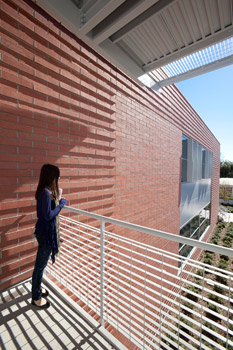Sustainable Planning and Design in K-12 Schools: Part 2
 Earlier this year, we began talking about the many planning, design, technology, and other strategies that can be used to green a new or existing school, in Sustainable Planning and Design in K-12 Schools. As we continue fleshing out these ideas in part two, we’ll turn our focus to “Energy and Atmosphere.”
Earlier this year, we began talking about the many planning, design, technology, and other strategies that can be used to green a new or existing school, in Sustainable Planning and Design in K-12 Schools. As we continue fleshing out these ideas in part two, we’ll turn our focus to “Energy and Atmosphere.”
Why am I spending an entire post on this topic? Because, in the U.S., buildings consume 39% of the nation’s total annual energy supply. They also create 48% of the country’s carbon dioxide emissions. And by putting green design strategies and technologies to work, we’ve seen our schools use 20 to 50% less energy, than traditional schools buildings, of the same use and nature.
Let me give you six simple features that can help reduce the greenhouse gas emissions and energy costs of your K-12 school.
1. Insulation—which keeps hot air out and cool air in during the summer, and cold air out and warm air in during the winter—is a simple and vital means of conserving energy. The kind of insulation selected for a green building is also critical. Conventional insulation often has toxins that can leak into the indoor environment. Green choices such as soybean-based insulation or cotton insulation, however, do not have these toxins while providing excellent building insulation.
2. A green roof also provides significant insulation that reduces the amount of heat that penetrates into the building interior, keeping the building cooler in summer, which lowers upfront air conditioning requirements and reduces long-term energy consumption. A green roof keeps the building interior warmer in winter by reducing the amount of heat loss, which lowers initial heating requirements and reduces long-term energy consumption. A green roof also significantly reduces—and sometimes eliminates—the rooftop heat island effect by absorbing solar heat, which further reduces a building’s air conditioning requirements and upfront costs, lowering energy consumption.
3. The lighting system is responsible for between 25 and 44% of an entire building’s energy consumption. A building with abundant natural daylighting will  need less artificial lighting, and it will use that artificial lighting system less, greatly reducing energy consumption. Of course, an artificial lighting system is still important. Indirect lighting systems, advanced fluorescent lamps and ballasts, compact fluorescent lamps, Light Emitting Diodes (LEDs), High Intensity Discharge (HID), and other lighting technologies all use significantly less energy than conventional lighting systems and components.
need less artificial lighting, and it will use that artificial lighting system less, greatly reducing energy consumption. Of course, an artificial lighting system is still important. Indirect lighting systems, advanced fluorescent lamps and ballasts, compact fluorescent lamps, Light Emitting Diodes (LEDs), High Intensity Discharge (HID), and other lighting technologies all use significantly less energy than conventional lighting systems and components.
Install occupancy and daylight sensors and controls to reduce artificial lighting use according to the amount of daylight in a space and whether or not a space is occupied to save even more energy.
4. The HVAC system should be energy efficient and it should not use ozone-depleting hydrochlorofluorocarbon (HCFC), Halon, or chlorofluorocarbon (CFC)-based refrigerants. When it comes to energy-conservation strategies, one of the most effective tools is an energy meter. Meter everything that uses energy, from the HVAC system on down to computers. Metering and monitoring energy-consuming equipment and building systems immediately raises a red flag whenever a boiler or a computer is not performing at optimal energy efficiency, enabling the facility manager to make any necessary programming or technology adjustments to maintain energy conservation standards and keep operating costs down.
 5. Renewable energy technologies include natural gas fuel cells. Geothermal systems draw heat from the earth to warm a building and expel heat into the earth to cool a building. Biomass systems burn biological wastes—everything from agricultural debris and weeds to manure and sewage sludge—rather than coal or oil to generate electricity.
5. Renewable energy technologies include natural gas fuel cells. Geothermal systems draw heat from the earth to warm a building and expel heat into the earth to cool a building. Biomass systems burn biological wastes—everything from agricultural debris and weeds to manure and sewage sludge—rather than coal or oil to generate electricity.
6. Photovoltaic systems are becoming more commonplace. These systems can be anything from rooftop panels to panels that shade surface parking lots, and solar technologies imbedded into the building façade, even the windows. School districts can also purchase Renewable Energy Credits from utility companies and other vendors to assure that a school is powered by renewable energy sources rather than oil and coal.
In Part Three of this Sustainable Planning and Design school series, I’ll give you some easy-to-digest advice about “Materials and Resources.” Want to do something now to start greening your campus? Get students involved. Initiate a school-wide recycling program. Or have student teams evaluate the school’s energy usage as class projects. The ideas are endless, and believe it or not, your community would love to get involved.
Dave Gilmore has more than 30 years of experience in the architectural design industry. A Principal at LPA Inc., Gilmore has left his mark on more than 200 K-12 schools. He has additional expertise in urban planning, commercial, retail, institutional, mixed-use and public architectural design. Dave is a LEED accredited professional (AP), and an active member of the American Institute of Architects (AIA) and the Coalition for Adequate School Housing (C.A.S.H.).
